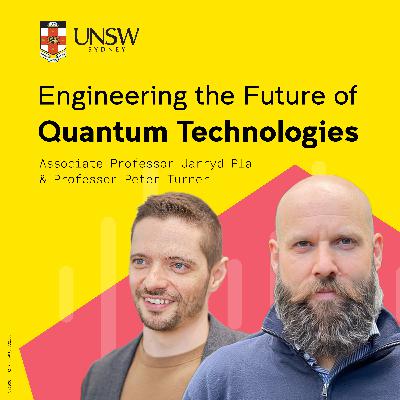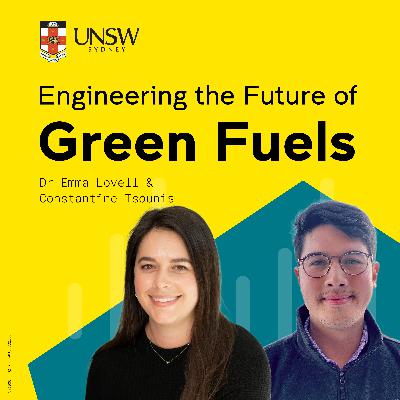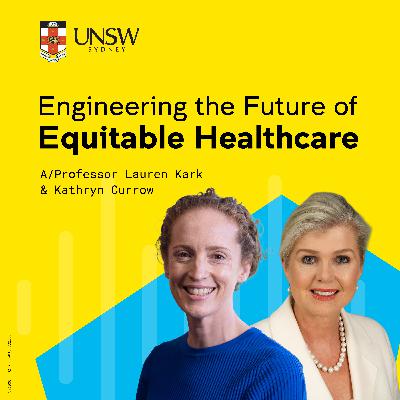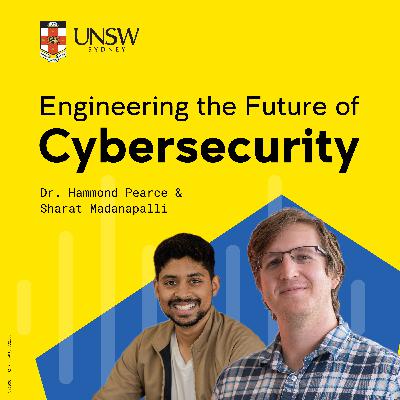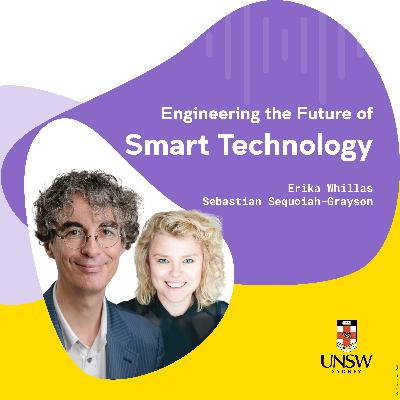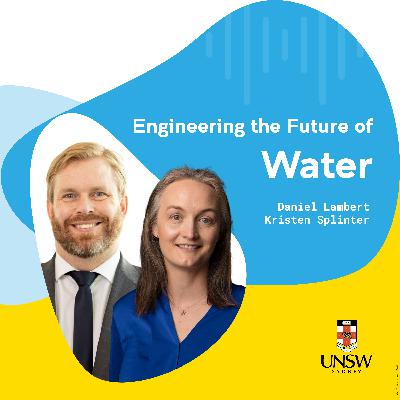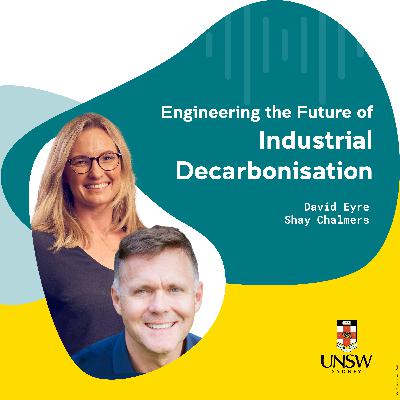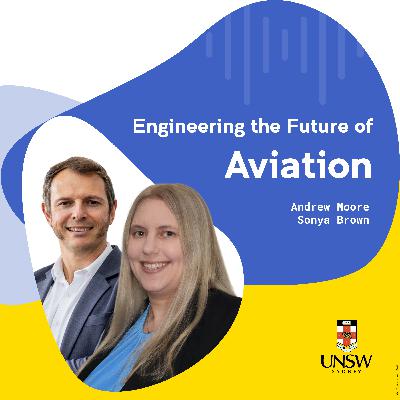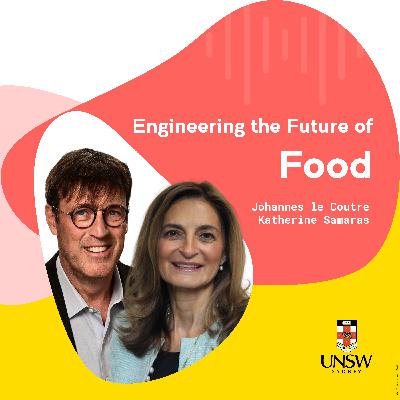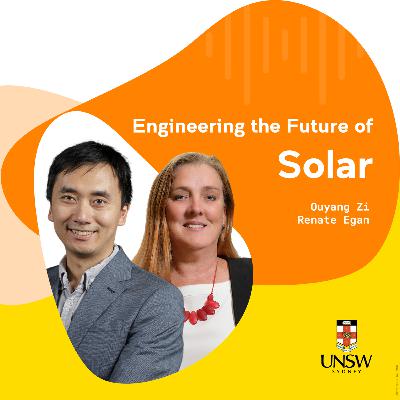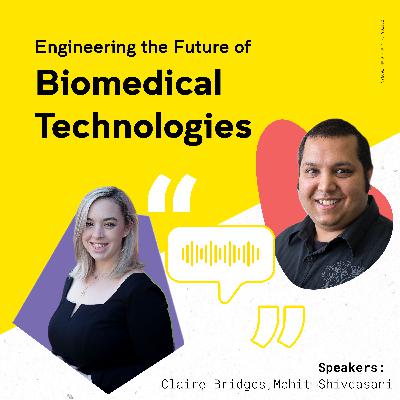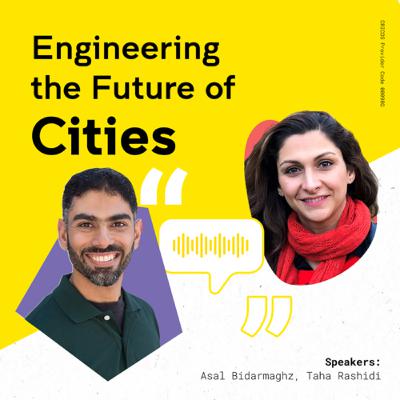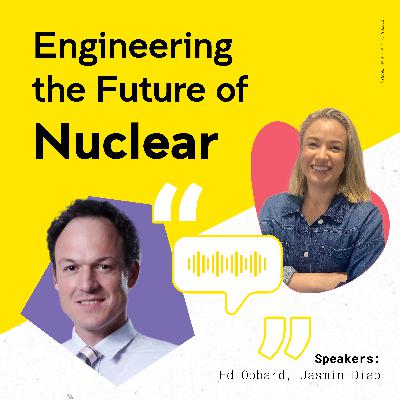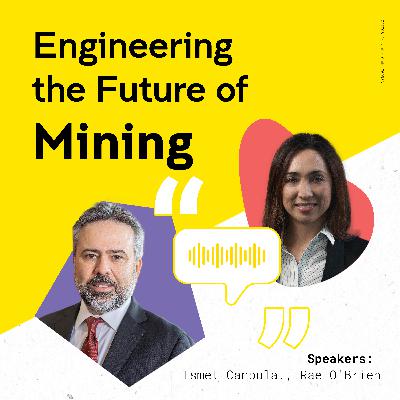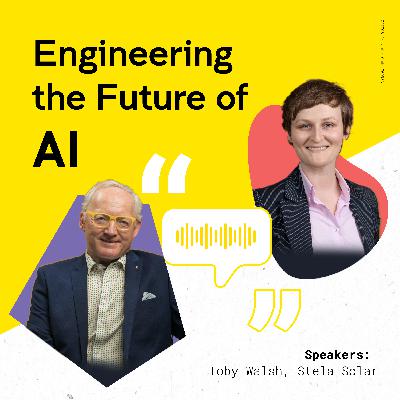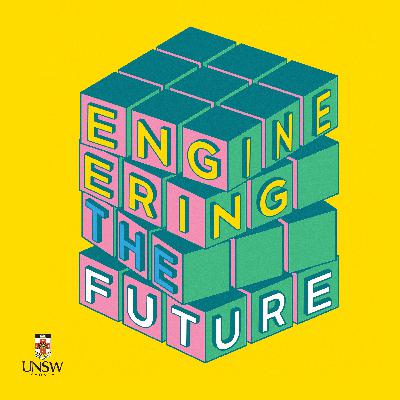Discover UNSW's Engineering the Future
UNSW's Engineering the Future

UNSW's Engineering the Future
Author: UNSW Engineering
Subscribed: 5Played: 69Subscribe
Share
© UNSW Engineering
Description
UNSW’s Engineering the Future podcast is a space for thought-provoking conversations about the bold ideas that will impact society over the next two decades.
From exciting developments in nuclear technology and major transformations in the mining industry, through to the universal impact of Artificial Intelligence, we speak with leading academics and industry leaders about the technological marvels that will define our future.
Together, we’ll discover how world-changing action starts with fearless thinking in innovative engineering.
From exciting developments in nuclear technology and major transformations in the mining industry, through to the universal impact of Artificial Intelligence, we speak with leading academics and industry leaders about the technological marvels that will define our future.
Together, we’ll discover how world-changing action starts with fearless thinking in innovative engineering.
19 Episodes
Reverse
Engineering touches almost every aspect of our lives. From building our roads and powering our homes to developing the medical equipment that will help save lives — the demand for engineering skills continues to grow. But Australia is facing one of its biggest skills shortages, with more than 60,000 engineers needed over the next decade.In the latest episode of Engineering the Future podcast, Professor Rita Henderson, UNSW Engineering’s Deputy Dean of Society Impact and Translation, and Kath Richards, Chief Engineer of Engineers Australia, chat with STEM journalist Neil Martin about what it takes to attract and retain diverse talent in engineering. From sparking interest in schools to creating flexible, supportive workplaces, they explore how diversity drives innovation and why it’s so important in tackling the world’s biggest challenges.For the full transcript of the episode and to learn more about our speakers, visit our website.Read more of our stories on Equity, Diversity, and Inclusion at UNSW:UNSW’s Gateway shines, as Education Minister announces rise in domestic enrolments Girls in STEMM 2025: Building circuits, racing cars and shaping tomorrow Hands-on engineering hits the road with UNSW Makerbus Meet Keira Moran: Engineering student and co-recipient of the 2025 Inspiring Student Award Honouring excellence: women engineers celebrated as distinguished Ada Lovelace Medal awarded Don’t miss out on more conversations about the technologies shaping our world. Subscribe to Engineering the Future on your favourite podcast platform and follow us on Facebook, LinkedIn, Instagram and BlueSky to stay up to date with the latest research and news from UNSW Engineering. Acknowledgement of Country We would like to show our respects and acknowledge the Bedegal people who are the Traditional Custodians of the Land on which our Kensington campus is situated on, and to Elders past and present.
For more than a century, quantum mechanics has challenged how we understand the universe. Once confined to theory and thought experiments, quantum is now powering real technologies – and the next 20 years could redefine how we live, work, and connect.In this episode of Engineering the Future, host Neil Martin speaks with UNSW Associate Professor Jarryd Pla, and Professor Peter Turner from Sydney Quantum Academy, about the breakthroughs and roadblocks of the quantum world. From GPS-free navigation and ultra-secure communications to the promise of quantum computing, we reveal where the engineering stands today, what’s coming next, and why Australia is uniquely placed to lead the charge. For the full transcript of the episode and to learn more about our speakers, visit our website.Read more of our stories on quantum technologies:This purple diamond could one day amplify signals from deep spaceHow a world record ‘squeeze’ could offer comfort for dark matter huntersUNSW engineers help crack key challenge in scaling quantum computersThis metaphorical cat is both dead and alive – and it will help quantum engineers detect computing errorsDon’t miss out on more conversations about the technologies shaping our world. Subscribe to Engineering the Future on your favourite podcast platform and follow us on Facebook, LinkedIn, Instagram and BlueSky to stay up to date with the latest research and news from UNSW Engineering. Acknowledgement of Country We would like to show our respects and acknowledge the Bedegal people who are the Traditional Custodians of the Land on which our Kensington campus is situated on, and to Elders past and present.
Using renewable energy such as wind and solar to create environmentally friendly electricity is great - but what can we do to replace the use of fossil fuels in industrial sectors that can't easily be electrified? This can include heavy manufacturing, aviation, maritime transport, and chemical production. These industries need high-density energy or specialised fuels and processes that electricity alone cannot provide efficiently. That's where green fuels come in. In this episode of Engineering the Future, UNSW lecturer Dr Emma Lovell and industry expert Constantine Tsounis, join STEMM journalist Neil Martin to explain how they are made and why they are so important. They discuss the process of turning renewable resources into biofuels, green hydrogen, biogas, and synthetic fuels to help drive the reduction of greenhouse gas emissions - making decarbonisation possible for even the hardest-to-abate sectors. For the full transcript of the episode and to learn more about our speakers, visit our website.Read more of our stories on Green Fuels: What is sustainable aviation fuel, and why are we not using it already? UNSW researchers to scale up development of clean aviation fuel thanks to $1.2m TRaCE award Roadblocks still abound en route to decarbonisation of Australia’s freight industry A carbon levy on global shipping promises to slash emissions. We calculated what that means for Australia’s biggest export Scientists use AI to make green ammonia even greener Don’t miss out on more conversations about the technologies shaping our world. Subscribe to Engineering the Future on your favourite podcast platform and follow us on Facebook, LinkedIn, Instagram and BlueSky to stay up to date with the latest research and news from UNSW Engineering. Acknowledgement of Country We would like to show our respects and acknowledge the Bedegal people who are the Traditional Custodians of the Land on which our Kensington campus is situated on, and to Elders past and present.
PFAS—also known as "forever chemicals"—are in your water, your clothes, your food packaging, and even in your body. They’ve been widely used for decades to make products resistant to heat, stains, grease, and water, including non-stick cookware, firefighting foam, and stain-resistant fabrics. But engineers, regulators, and the public are increasingly concerned about their long-term impact. In this episode of Engineering the Future, environmental engineers, UNSW Professor Denis O’Carroll and Andrew Mitchell from ADE Consulting, joins STEMM journalist Neil Martin to unpack the science behind PFAS and how they ended up in our environment. They explain the new detection and removal methods used to clean up PFAS, and emphasise the need for better regulation, public awareness, and the development of better alternatives of the chemical. For the full transcript of the episode and to learn more about our speakers, visit our website.Read more of our stories on PFAS: Specific ‘forever chemical’ found at unexpected levels in firefighting foam New method to degrade PFAS ‘forever chemicals’ found effective in the lab PFAS 'forever chemicals' above drinking water guidelines in global source water Trying to solve the 'forever problem' of PFAS pollution Don’t miss out on more conversations about the technologies shaping our world. Subscribe to Engineering the Future on your favourite podcast platform and follow us on Facebook, LinkedIn, Instagram and BlueSky to stay up to date with the latest research and news from UNSW Engineering. Acknowledgement of Country We would like to show our respects and acknowledge the Bedegal people who are the Traditional Custodians of the Land on which our Kensington campus is situated on, and to Elders past and present.
Not all healthcare is created equal. Whether it’s a postcode that limits your services, a language barrier at the clinic, or a system that overlooks accessibility - too many people are being left behind. But how do we build healthcare systems that can fairly serve its communities regardless of postcode, income, or identity? In this episode of the Engineering the Future podcast, UNSW’s biomedical engineer Associate Professor Lauren Kark, and Managing Director of Taking Paediatrics Abroad, Kathryn Currow, chats with STEM journalist Neil Martin, about the challenges of ensuring healthcare that is just for all and the importance of advocating for sustainable solutions and capacity building over mere financial investment.For the full transcript of the episode and to learn more about our speakers, visit our website.Read more of our stories on equitable healthcare: It works! GeneEQUAL is improving health care for people with intellectual disabilityUNSW Kirby Institute’s remote testing program wins major university award UNSW medicine graduate awarded NSW Rhodes Scholarship Don’t miss out on more conversations about the technologies shaping our world. Subscribe to Engineering the Future on your favourite podcast platform and follow us on Facebook, LinkedIn and Instagram to stay up to date with the latest research and news from UNSW Engineering. Acknowledgement of Country We would like to show our respects and acknowledge the Bedegal people who are the Traditional Custodians of the Land on which our Kensington campus is situated on, and to Elders past and present.
📧 Have you ever fallen victim to a phishing email? You're not alone. Cybersecurity threats are growing more sophisticated every day, making the protection of personal and corporate data more critical than ever. As artificial intelligence reshapes both attack methods and defence strategies, what are the risks of not securing our infrastructure against emerging threats?Lecturer at UNSW School of Computer Science and Engineering and former NASA researcher, Dr. Hammond Pearce, and Director of InTune AI, Sharat Madanapalli, joins STEMM journalist Neil Martin to unravel the evolving landscape of cybersecurity and how to safeguard your privacy online. For the full transcript of the episode and to learn more about our speakers, visit our website. Read more of our stories on cybersecurity: What to do about deepfakes: opportunities and problems as AI tech makes leaps and bounds Today’s top cybersecurity threats for consumers, and how to fight them Beware the dangers of data breach fatigue An award-winning breakthrough in computer science education The internet of things: protecting network assets and infrastructure Let’s connect: Don’t miss out on more conversations about the technologies shaping our world. Subscribe to Engineering the Future on your favourite podcast platform and follow us on Facebook, LinkedIn and Instagram to stay up to date with the latest research and news from UNSW Engineering. Learn more about UNSW Institute of Cybersecurity. Acknowledgement of Country We would like to show our respects and acknowledge the Bedegal people who are the Traditional Custodians of the Land on which our Kensington campus is situated on, and to Elders past and present.
From smart homes and cities to business and healthcare, smart technology is promising to enhance efficiency, convenience, and connectivity in daily life. But with it comes growing concerns about data security, reduced privacy, and the control of information.
Dr Sebastian Sequoiah-Grayson, Senior Lecturer in Epistemics at UNSW's School of Computer Science and Engineering, and senior experience strategist Dr Erika Whillas join STEMM journalist, Neil Martin, to discuss how smart technology will change the way we live and interact with our communities in the future - and how best to deal with the challenges it will undoubtedly create.
Too much water in the form of flooding, or too little water in the form of drought. Two of the biggest global challenges when it comes to water are at completely opposite ends of the spectrum.
UNSW Associate Professor Kristen Splinter, and water
engineering executive Daniel Lambert join STEMM journalist Neil Martin to talk about the potential solutions to those crucial problems.
They discuss the importance of ensuring the ever-increasing global population has safe water to drink, and enough water to also grow suitable amounts of food, while also dealing with issues around flooding and sea
level rises.
Industrial decarbonisation is a fundamental way Australia and other countries around the world can achieve 'Net Zero' emissions targets by 2050, and therefore fulfil promises made in the Paris Agreement to help reduce climate change.
David Eyre, CEO of the UNSW Institute for Industrial Decarbonisation, and engineering and manufacturing executive Shay Chalmers join STEMM journalist Neil Martin to talk about the challenges of decarbonisation as populations grow and demand for products such as cement, steel, plastic and ammonia rise as a result.
They will explain why fostering collaborations and partnerships is important to keep producing such important materials while also reducing greenhouse gas emissions, and provide analysis about new decarbonisation technologies, revealing how technical and economic feasibility is just one part of the whole process.
Supersonic commercial planes are making a comeback, but it may be only high flyers that can afford them.
For everyone else, our cities could soon drastically change as flying cars (but not as we imagine them) are set to extend the reach of our cities and slash commute times.
UNSW senior lecturer in aerospace design, Dr Sonya Brown, and sustainable aircraft designer Andrew Moore join STEMM journalist Neil Martin to talk about the future of flight. They also debunk myths about hydrogen fuel dating back to the Hindenburg blimp disaster, discuss the use of drones to save lives by fighting bushfires, and explain the tricky balancing act needed to make flying more sustainable.
800 million people currently go to sleep hungry, but 1 in 4 of us are predicted to be obese by 2035. Securing access to food for everyone and making it sustainable for our planet are some of our greatest challenges. Professor Johannes le Coutre, the leader of UNSW’s food program, and Katherine Samaras, Laboratory Head of the Garvan Institute and specialising in diabetes and obesity prevention, join STEMM journalist Neil Martin to talk about potential solutions for keeping us fed and the planet happy. They discuss why looking back to old agricultural techniques could hold some answers, and how diabetes drug Ozempic isn’t the fix for over-eating.
UNSW researchers are largely responsible for the way the world uses solar power today. Decades of innovation on photovoltaic cells from people at this very university have helped the world get a running start on the global green energy transition. But there’s more work to be done. A lot more.
Executive Director for the Australian Centre for Advanced Photovoltaics, Professor Renate Egan, and Vice-President of world-leading solar module manufacturer JA Solar, Dr Zi Ouyang, join STEMM journalist Neil Martin to discuss how the industry is making leaps and bounds, what’s happening with old rooftop panels and the potential for covering houses in solar cell ‘paint’.
It might seem like something out of Star Trek, but people controlling so-called ‘smartbrains’ with their own thoughts could happen sooner than you think. And it doesn’t stop there. Innovations in biomedical technologies is speeding the progress of things such as artificial lab-grown organs, nanorobots inside the body, or computers hardwired to the brain which is becoming common in the next 20 years.
On UNSW’s Engineering the Future podcast, Associate Professor Mohit Shivdasani and Claire Bridges talk to STEM journalist Neil Martin, about how the science-fiction of bionic humans is now rapidly becoming a reality.
For more information on our speakers or for a full transcription of this episode, visit our website.
Read more of our stories on biomedical technologies:
Mimics human tissue, fights bacteria: new biomaterial hits the sweet spot
New 3D stretchable electronics can advance organ-on-chip technology
Bio-inspired: developing technology to mimic the function of skin
ARC Research Hub for Connected Sensors for Health opens at UNSW
Let’s connect:
Follow us on Facebook, LinkedIn and Instagram to stay up to date with the latest research and news from UNSW Engineering.
Acknowledgement of Country
We would like to show our respects and acknowledge the Bedegal people who are the Traditional Custodians of the Land on which our Kensington campus is situated on, and to Elders past and present.
As the world is expected to gain 2.2 billion new urban residents by 2050, emerging
technologies will dramatically transform the way growing populations live, work and commute in urban areas. What will this mean for the future of urban engineering?
Transport engineering expert, Associate Professor Taha Rashidi, and geotechnical engineering expert, Dr Asal Bidarmaghz look up to the skies and discuss the feasibility of flying cars and drones as a form of transport, as well as looking down by making the case for increased infrastructure to be built underground.
For more information on our speakers or for a full transcription of this episode,
visit our website.
Read more of our stories on future cities:
The only way is... down! Why underground urban development is on the rise
Tiny pocket parks make a big impact on urban living
To deliver enough affordable housing and end homelessness, what must a national strategy do?
Regional cities: not a simple housing solution for metropolitan growth pressures
Let’s connect:
Follow us on Facebook, LinkedIn and Instagram to stay up to date with the latest research and news from UNSW Engineering.
Acknowledgement of Country
Wewould like to show our respects and acknowledge the Bedegal people who are the
Traditional Custodians of the Land on which our Kensington campus is situated
on, and to Elders past and present.
The energy landscape is evolving and it’s demanding change in the way we produce and consume energy in a more sustainable way. But how can our industry leaders, policymakers and household users reap the benefits of new technologies to meet these demands? Director of UNSW Digital Grid Futures Institute, Professor John Fletcher, and CEO of UNSW Energy Institute, Dani Alexander, joins STEM journalist, Neil Martin, to discuss the challenges of redesigning entire energy systems to help meet the goal of net zero greenhouse gas emissions by 2050.
For more information on our speakers or for a full transcription of this episode, visit our website.
Read more of our stories on energy:
Farm dams can be converted into renewable energy storage systems: study
Renewable backup power key to energy resilience in disasters: report
The future of hydrogen fuel: UNSW researchers develop technique to analyse hydrogen
fuel cell stability
New environmentally friendly solar panel recycling process helps recover valuable silver
Embodied carbon in buildings: a new frontier in greenhouse gas reduction
Let’s connect:
Follow us on Facebook, LinkedIn and Instagram to stay up to date with the latest research and news from UNSW Engineering.
Learn more about Digital Grid Futures Institute and the UNSW Energy Institute.
We would like to show our respects and acknowledge the Bedegal people who are the Traditional Custodians of the Land on which our Kensington campus is situated on, and to Elders past and present.
The on-going debate on nuclear feels like a constant battle of weighing the benefits of low carbon electricity generation against the public perception of potential risks.
Nuclear engineer and lead of UNSW’s Nuclear Engineering program, Dr Edward Obbard, and Lieutenant Colonel Jasmin Diab, join STEM journalist, Neil Martin, to discuss exciting developments in nuclear engineering and discuss what impacts we can expect on society as a whole over the next two decades.
For more information on our speakers or for a full transcription of this episode, visit our website.
Read our stories on nuclear technologies:
Three tiers and more than 8000 new engineers: what it will take to deliver AUKUS nuclear submarine program
Blockchain could be the key to nuclear material safeguards
Nuclear submarines not the first step to nuclear weapons, says UNSW expert
Let’s connect:
Follow us on Facebook, LinkedIn and Instagram to stay up to date with the latest research and news from UNSW Engineering.
We would like to show our respects and acknowledge the Bedegal people who are the Traditional Custodians of the Land on which our Kensington campus is situated on, and to Elders past and present.
As the world shifts towards renewable energy production, experts predict that mining will play a critical role in the extraction of minerals necessary for technologies like solar panels, wind turbines, and electric vehicle batteries.
Head of UNSW School of Minerals Energy Resources Engineering, Professor Ismet Canbulat, and Rae O'Brien, Executive General Manager of Mining Excellence with Centennial Energy Company, joins STEM journalist, Neil Martin, to discuss the role of mining as the world transitions to a greener future.
For more information on our speakers or for a full transcription of this episode, visit our website.
Read more of our stories on mining:
8 things you never knew about mining on Mars, the Moon... and even asteroids!
Humans have big plans for mining in space – but there are many things holding us back
Mars settlement likely by 2050 says UNSW expert – but not at levels predicted by Elon Musk
Lunar architecture: small step for 3D printers, giant leap for humankind
Let’s connect:
Follow us on Facebook, LinkedIn and Instagram to stay up to date with the latest research and news from UNSW Engineering.
We would like to show our respects and acknowledge the Bedegal people who are the Traditional Custodians of the Land on which our Kensington campus is situated on, and to Elders past and present.
AI-powered programs like ChatGPT can do everything from plan an itinerary for your next holiday or help you write a resume or business proposal. But with all great technologies, there are risks and challenges.
AI expert and Chief Scientist at UNSW's AI Institute, Professor Toby Walsh, and Stela Solar, Director of the National Artificial Intelligence Centre hosted by CSIRO's Data61, join STEM journalist, Neil Martin, to take a deep dive into the impact of AI on society in areas including healthcare, transport, education and defence.
For more information on our speakers or for a full transcription of this episode, visit our website.
Read more of our stories on AI:
The defence review fails to address the third revolution in warfare: artificial intelligence
Gaslighting, love bombing and narcissism: why is Microsoft's Bing AI so unhinged?
Everyone's having a field day with ChatGPT – but nobody knows how it actually works
Bard, Bing and Baidu: how big tech's AI race will transform search - and all of computing
Can machines invent things without human help? These AI examples show the answer is 'yes'
Have you given away secrets on ChatGPT?
Let’s connect:
Follow us on Facebook, LinkedIn and Instagram to stay up to date with the latest research and news from UNSW Engineering.
Visit the UNSW AI Institute website to learn more about exciting developments in AI, data science and machine learning.
We would like to show our respects and acknowledge the Bedegal people who are the Traditional Custodians of the Land on which our Kensington campus is situated on, and to Elders past and present.
UNSW’s Engineering the Future podcast is a space for thought-provoking conversations about the bold ideas that will impact society over the next two decades.
From exciting developments in nuclear technology and major transformations in the mining industry, through to the universal impact of Artificial Intelligence, we speak with leading academics and industry leaders about the technological marvels that will define us as we work towards a more sustainable future for all.
Together, we’ll discover how world-changing action starts with fearless thinking in innovative engineering.



